THE CLANDON BARROW LOZENGE AND THE FOLKTON DRUMS.
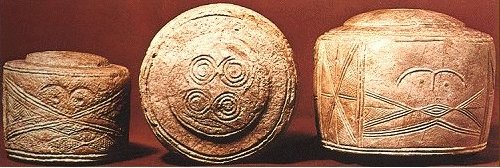
A commentator writes the following about these 3 chalk drums
found in a small child's grave:
'Although these beautiful objects were
found in Yorkshire (several hundred miles from Wessex) they are yet another
remarkable example of the art of the late Neolithic and early Bronze Age. What
is the significance of the owl-like face? Is this just another display of the
artist's love of symmetry or does it represent an animal or some long forgotten
deity?'
http://freespace.virgin.net/philip.dunn/sites/artefacts.htm
Let's look at the totality of design work displayed upon the drums:

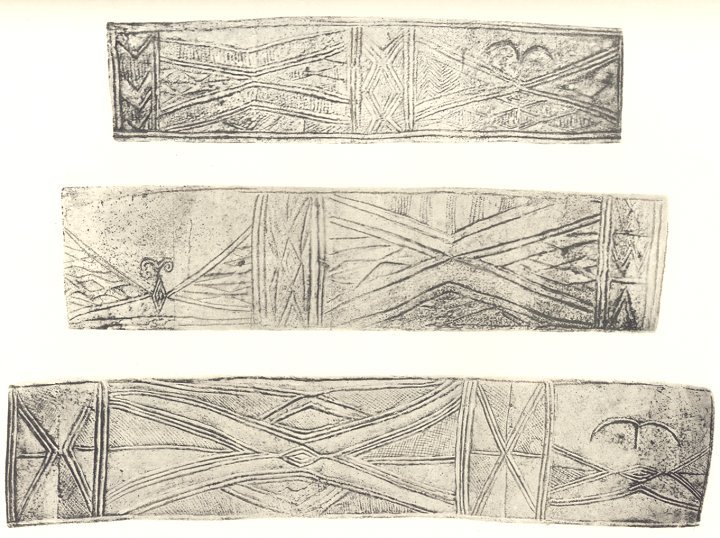
http://www.stone-circles.org.uk/stone/folkton.htm
The full designs around each drum are shown in these pictures.
Strangely enough, there seems to be a relationship between some pictorial representations
occurring on the drums and the identifiable geometry of the Clandon Barrow Lozenge...
Perhaps descendants of the Wessex folk can see this as readily as can this descendant
of French/ Basque sheepherders from Southern France's Languedoc province.
THROUGH THE EYES OF THE OWL
It's very evident that the Clandon Barrow Lozenge was first set out according
to circle geometry, prior to any inscribing of the precious metal surface.
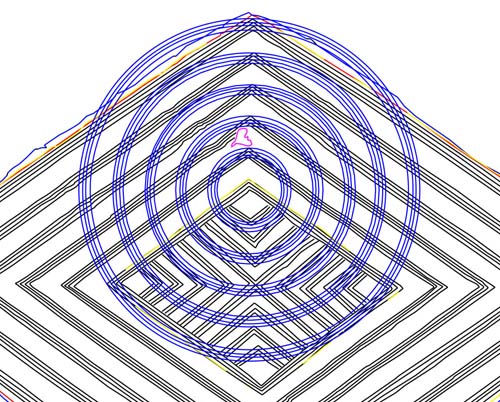
The Clandon Barrow Lozenge is made up of 6 sets of lozenge
diamond patterns diminishing inward. The innermost of these has its own set
of cross and chevron/ lozenge patterns. The station or fulcrum position for
the circles (shown above) is the inner point of the 6th inward lozenge. With
each expanding circle, dynamic ancient numbers or ratios are positively identified
in the measurements achieved...based upon the (so-called) British Standard inch,
which was used in Sumeria and Egypt at yet earlier epochs. Let's identify each
coded length.
SECTION 1.
- 1.35 inches radius (2.70 inches diameter)...degrees of arc in a 360-degree
circle. Breaking a circle to the 4 cardinal points, 90, 180, 270, 360 &
secondary points, 45, 135, 225 & 315-degrees respectively.
- 1.32 inches radius (2.64 inches diameter)...overland distance according
to the "11" series of league (16500 ft), mile (5280 ft), furlong
(660 ft), chain (66 ft), rod/ perch (16.5 ft), fathom (originally 5.5 ft),
link (7.92 inches). The "Z" Holes Circle at Stonehenge is 132 feet
in diameter. The Station Stones rectangle at Stonehenge has a long side of
264 feet.
- 1.296 inches radius (2.592 inches diameter)...relates to the Precession
of the Equinoxes in years and also to navigation. The Heel Stone (outer face)
sits 259.2 feet from the centre of Stonehenge.
- 1.26 inches radius (2.52 inches diameter)...relates to a measurement called
the Hebrew reed of 10.5 feet. This is a "6&7" measurement based
upon 42". The Greek foot was 12.6 inches and the Assyrian cubit was 25.2
inches . Each lintel inner face at Stonehenge was 1 reed of 126 inches long.
The large ornate stone at New Grange is 1 reed long (?).
SECTION 2.
- 1.08 inches radius (2.16 inches diameter)...relates to the precession of
the equinoxes, wherein the sun spends 2160 years in each of the houses of
the zodiac during the 25920 year cycle of precession. The moon is 2160 miles
wide. A progression based upon 1.08 is remarkably useful for many lunar, solar
and navigational functions.
- 1.056 inches radius, (2.112 inches diameter)...relates to overland distances
based upon the "11" series mile (5280 feet). A circle running along
the embankment rim at Stonehenge was configured to be 1056 feet in length.
It was used for determining exact degree angles of alighting stars, using
set 3,4,5 triangles (created by Aubrey Circle post positions combined with
the use of ropes).
- 1.030909090 inches radius (2.061818182 diameter)...relates to several Egyptian
Royal Cubits, which were coded lengths for determining the equatorial size
of the Earth under (up to) 6 separate systems. This station on the lozenge
would have provided an increased mnemonic function for remembering the lengths
of each separate cubit.
- 1 inch radius (2 inches diameter)...gives a reference for correct inch or
2 inch intervals.
SECTION 3.
- .83333 inches radius (1.666666 inches diameter)....this station provides
one of the most used codes or ratios of antiquity. In a 3,4,5 triangle the
adjacent is 1.66666 to 1 less in length than the hypotenuse. The vertical
height of the Great Pyramid to the top of its flat altar floor (453.6 feet)
is 1.66666 less than the length of its base (756 feet).
- .81 inches radius (1.62 inches diameter)...this station is double coded
and relates to a "rounded" PHI inch (1.62 inches) and a pure PHI
inch (1.6180339 inches). The half values for these are .81 and .80901695 inches
respectively. The length of 80.901695 inches was the Megalithic Rod proposed
by Alexander Thom. Many ancient structures were built to comply to 1.62 inch
increments in their dimensions so that they would comply very closely to pure
PHI values. The Great Pyramid's base measurement @ 756 feet (9072 inches)
is 5600 rounded PHI inches of 1.62". Both rounded PHI or pure PHI increments
were very important to the layout of Stonehenge.
- .7875 inches radius (1.575 inches diameter)...this is a very important mathematical
progression that relates to the lunar cycle, navigation and the Sabbatical
calendar system.
- .756 inches radius (1.512 inches diameter). This is a multifunctional number
found in the dimensions of the Great Pyramid (756 feet per side). The sum
of 1512 feet is 1/4th of one minute of equatorial arc under the Great Pyramids
geodetic assignment.
SECTION 4.
- .5833333 inches radius (1.16666666 inches diameter)...this is one of the
most used numbers or ratios of antiquity. The common cubits of ancient nations
were 1.166666 in length less than their Royal Cubit counterparts. The perimeter
value of the Great Pyramid (3024 feet...1/2 a minute of Earth equatorial arc)
÷ 58.33333 = 51.84 (the slope angle of the Great Pyramid's 4
faces and a primary navigational value). 58.33333 inches (alternative reading
58.32 inches) was the length of a Roman Pace.
- .55 inches radius (1.1 inches diameter)...this relates to the "11"
series navigational system and to the ancient fathom of 5.5 feet. The design
diameter of the Sarsen Circle (OD) at Stonehenge was 110 feet or 20 fathoms
(based upon a PHI sequence reduction down from the Aubrey Circle and "Y"
Holes). Silbury Hill was built to be 550 feet in diameter in order to display
a very important navigational number (1728 feet) in its circumference. This
relationship between an "11" series diameter producing a "6"
series circumference (divisible by 360-degrees) was much exploited in ancient
navigational plotting. This station would have been used for recall of .56
inches radius (1.12 inches diameter) and .54 inches radius (1.08 inches diameter)
used in solar and lunar calculations. There were 56 posts on the Aubrey Circle
at Stonehenge, which were used to calculate solar and lunar positions within
the lunisolar calendar system or the lunar nutation cycle.
- .528 inches radius (1.056 inches diameter)...this relates to the mile of
5280 feet, but the priest/ scientist using the Clandon Barrow Lozenge as a
memory device would have also used the station to recall 5250 feet, which
became the Greek mile. 5280 was a value in the "11" series navigational
system and 5250 was a value in the "6&7" navigational system.
- .504 inches radius (1.008 inches diameter)...this relates to navigation,
wherein 100.8 feet represented 1 second of Earth equatorial arc under the
Great Pyramid's assignment. A cross measurement of one part of the inner Sarsen
Circle at Stonehenge is 100.8 feet (1 second of equatorial arc).
SECTION 5.
- .33 inches radius (.66 inches diameter)...this relates to navigation under
the "11" system. The station would have been triple read as .32
inches radius (.64 inches diameter) or .315 inches radius (.63 inches diameter)
for remembering 1/8th, etc., segmentation of 360 degrees or calculation aspects
within the lunisolar Sabbatical Calendar system.
- .3024 inches radius (.6048 inches diameter)...this relates to the dimensions
of the Great Pyramid, wherein the perimeter measurement was 3024 feet. Two
circuits of the Great Pyramid (6048 feet) was a minute of equatorial circumference
arc under the "6&7" numerical reading. This station on the lozenge
would have been dual coded to also mean 3025 feet, which represented the perimeter
value of the Great Pyramid under it's "11" series navigational assignment,
wherein 2 circuits or 6050 feet represented 1 minute of equatorial arc.
- .275 inches radius (.55 inches diameter)...this mnemonic interval on the
lozenge was for recall of the "11" progression used in navigation
or in lengths like the fathom, rod, chain or furlong, etc.
- .256 inches radius (.512 inches diameter)...this relates to a numerical
progression in a series based upon the number 1152, important to ancient navigation.
Although the Clandon Barrow Lozenge would have been fashioned to the greatest
visual precision possible and could achieve excellent relative accuracy in larger
dimension readings, it was, essentially, a memory device. The purpose of the
lozenge was to be a repository or library of important, much used ratios and
other mult-use numerical values. Frequently, the owner of the lozenge would
need to refer to the device for recall of codes encrypted into each station.
If a principle was forgotten, it could be retrieved with a set of calipers,
extended between stations, which would then be placed against a finely calibrated
ruler. Astute scientists would need to, periodically, hone their skills to keep
the multitude of codes in memory and pass on the valuable information to initiates
of the mathematical and navigational arts. The greatest known repository of
these "out of Egypt" codes resides within the 3000 standing stone
positions at Carnac (Le Ménec), Brittany, France.
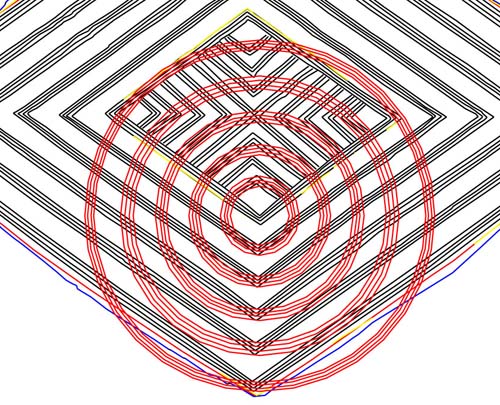
The observant researcher will begin to recognise a design methodology emerging,
which shows offsets of the lozenge lines (left to right) or amidst the innermost
pattern lines to make them comply to the diminishing circle geometry. Here
is an explanation of the codes found on each lozenge point within this quadrant:
SECTION 1.
- 1.3824 inches radius (2.7648 inches diameter). The Great Pyramid has a length
of 440 Egyptian Royal Cubits per side, creating a circumference (using PI
@ 3.141818182) of 138.24 Egyptian Royal Cubits (of 20.61818182 inches each).
Such a circle then breaks down into degrees, based upon a progression of the
much used ancient number, 11.52. A circle of 138.24 feet is 12 segments of
11.52 feet. The outer rim of the Sarsen Circle at Stonehenge was 345.6 feet
or 30 X 11.52 feet...indicating that the design length of each linel (outer
face) was 11.52 feet (138.24 inches). The outer Sarsen Circle circumference
was 138.24 feet X 2.5. The primary function of the 138.24 number was related
to creating a suitable circuit for calibrating the period of the moon within
the 6804 day lunar nutation cycle. The 138.24 number was also important to
ancient surveyors or navigators for calibrations related to the equatorial
size of the Earth under the "6&7" series (130636800 feet) or
the 12 X 12 X 12 X 12 X 1.2 "true" equatorial rendition of 131383296
feet.
- 1.3608 inches radius (2.7216 inches diameter)...this is a very important
calibration value within the 6804 day lunar nutation cycle and 136.08 days
would be 1/50th of the period. There would be 4.608 (1.152 X 4) lunar months
of 29.53125 days in 136.08 days. Again, the 11.52 value (associated with lunar
months this time) reveals its importance.
- 1.33333 inches radius (2.66666 inches diameter)...a very important conversion
ratio and mathematical progression. 10 ÷ 1.3333333 = 7.5 or
6 X 1.333333 = 8.
- 1.3125 inches radius (2.625 inches diameter)...this is a very important
lunar progression, simultaneously to relating to the "reed" length
of 10.5 feet. Values occurring in this progression relate to the dimensions
of the Khafre Pyramid (Egypt's Pyramid of the Moon). One of the concepts of
ancient metrology, which survived into mediaeval times, was that 75 Roman
miles represented 1-degree of arc for the world, although scholars of the
time had, seemingly, no lingering knowledge of the actual, former length of
a Roman foot...until professor of geometry, John Greaves did a careful reassessment,
in Rome, in 1639AD. If we multiply a Roman foot of 11.66666 inches X 5000
we get a Roman mile of 58333.3333-inches (or 1000 Roman Paces). If 75 such
Roman miles represent 1-degree of arc for the world, then that equates 364583.33333
British feet of 12-inches each. This value, multiplied by 360 = 131250000
British feet or 135000000 Roman feet. These lengths are also 12500000
Hebrew Reeds of 10.5 feet each or 125000000 Greek feet of 12.6-inches each.
Essentially, this very plausible coded representation for the size of the
Earth is a purely "7" series way of calibrating the equatorial circumference.
The sum of 131250000 feet equals 24857.955455 British miles, 27000 Roman miles
or 25000 Greek miles. This same circumference was probably 5000 Egyptian Atur
of 26250 British feet each.
SECTION 2.
- 1.1 inches radius (2.2 inches diameter)...this relates to the "11"
series measurements (league, mile, furlong, chain, rod, etc.).
- 1.066666 radius (2.13 inches diameter)...this is a conversion ratio. The
length of the Great Pyramid is 756 feet. When this value is divided by 1.0666666,
then the result is the length of the Khafre Pyramid. Therefore: 756 ÷
1.066666 = 708.75 feet. The Khafre Pyramid is 15/16ths the length of the Great
Pyramid.
- 1.03125 inches radius (2.0625 inches diameter). This station would have
been muti-coded to remember the lengths of several Egyptian Royal Cubits,
all of which provided a simple formula for calculating the equatorial size
of the Earth under separate systems.
- 1 inch radius (2 inches diameter). This station duplicates a station exactly
opposite on the lozenge.
SECTION 3.
- .825 inches radius (1.65 inches diameter)...this relates to measurements
within the "11" series. The ancient league was 16500 feet and the
rod or perch were 16.5 feet.
- .792 inches radius (1.584 inches diameter)...this relates to the equatorial
size of the Earth under the "11" series geodetic system, which viewed
the circumference as 24750 miles. A league was 3.125 miles and, under this
assignment, the Earth was 7920 leagues in circumference. It is, quite literally,
7920 miles in diameter. This station would have been triple coded and would
also be read as .7875 inches radius and .7865 inches respectively, providing
a progression for the period of the moon, as well as for PI @ 3.1416.
- .768 inches radius (1.536 inches diameter)...this is a part of a very important
progression leading to 11.52, used for navigational and lunar calibration
functions.
- .73828125 inches radius (1.476525 inches diameter)...this relates to the
lunar synodic month of 29.53125, as encrypted into the dimensions of Khafre
Pyramid in Egypt. 7.3828125 days = 1 lunar week. Although this value appears
difficult, it's easily extractible from the dimensions of the Khafre Pyramid
on the Giza Plateau.
SECTION 4.
- .56 inches radius (1.12 inches diameter)...this relates to the number 56,
which was very important for counting out periods within the Sabbatical calendar
system. Ancient lunarists used 28 lunar mansions for their calculations (56
÷ 2). There were 56 posts on the Aubrey Circle at Stonehenge,
especially arranged for calendar counts and 3,4,5 triangle work (using ropes).
The number 56 was used extensively in navigation and a diameter of 56 feet
translates to a circumference of 176 feet (using the PI rendition of 22/7...3.142857143).
The number 176 is used in the "11" series lengths, with 1760 yards
to a mile. Beyond 56, the numbers 55 & 54 were very important and this
station would have been used for mnemonic recall of those other values as
well.
- .533333 inches radius (1.066666 inches diameter)...this number was for ratio
reductions or increases. 16 ÷ 1.06666 = 15.
- .50625 inches radius (1.0125 inches diameter)... this is a very important
lunar progression, which delivers up many important numbers related to the
period of the moon.
- .48 inches radius (.96 inches diameter)... this relates to 48, which was
used extensively in "6" series calculations. If the Great Pyramid
had been built with an apex, rather than a flat floor altar (at 453.6 feet
of vertical height), it would have achieved a coded design height of 480 feet.
In ancient calculation, the pyramid was often viewed as having an apex section,
although it was imperative to the coded attributes of the pyramid that it
have a flat top altar section.
SECTION 5.
- .31104 inches radius, (.62208 inches diameter)...this relates to navigation
and the equatorial circumference of the Earth under its ancient "true"
assignment of 12 X 12 X 12 X 12 X 1.2 miles. Under this assignment 3110.4
miles was a 1/8th segment or 45-degrees of arc.
- .28 inches radius (.56 inches diameter)...this is for calendar work. The
second (symbolic) alternative is, .288 inches radius (.576 inches diameter)...this
is another mult-use number of antiquity and the Aubrey Circle at Stonehenge
is 288 feet in diameter. The design, diagonal length up the side of the Menkaure
Pyramid was 288 feet. The diagonal length up the Great Pyramid to its altar
floor was designed to be 576 feet. An Egyptian Pyramid acre (from clues within
the writings of Herodotus) was 28800 square feet. The Great Pyramid had a
value of 51.84 pyramid acres for its sides and base area. Menkaure Pyramid
was 11.52 pyramid acres for its sides and base area.
- .2592 inches radius (.5184 inches diameter)...this is one of the most versatile
and used progressions of antiquity. The Heel Stone outer face at Stonehenge
sits 259.2 feet from the centre of the site. There were 25920 years in the
ancient calculation for the Precession of the Equinoxes. The slope angle of
the Great Pyramid is 51.84-degrees. The Great Pyramid's base covers an area
of 5184 square reeds. The design slope angle for Menkaure Pyramid was 51.84-degrees
The azimuth angle at the Octagon of Newark, Ohio is 51.84-degrees from the
altar, through the avenue and out the centre of the most extremely distant
gate between embankments.The diameter of 1 league (16500 feet) creates a circumference
of 51840 feet (using 3.141818182).
- .23333 inches radius (.466666 inches diameter) ...this is a useful ratio
(14 ÷ 3). There would be 466.66666 rounded PHI feet of 1.62
British Standard feet in the length of the Great Pyramid.
Let's now combine the circle geometry, top and bottom to form the "Owl
Eyes":
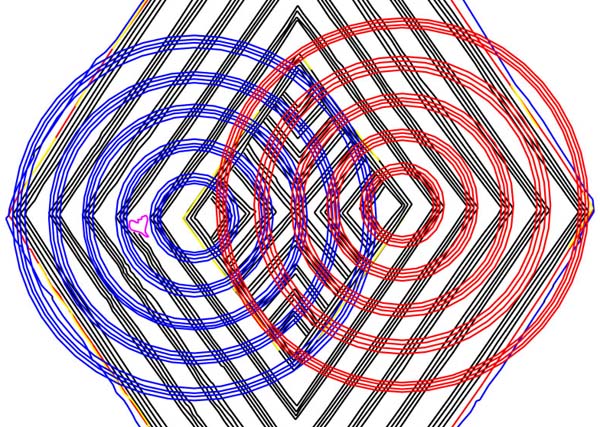
Based upon clues found on the Folkton Drums, concentric circles were sent
out from 2 fulcrum points to stations within 2 quadrants of the Clandon Barrow
Lozenge. The clear result of sending out these circles of specific, coded diameters,
was to discover the ancient artisan's method, used to mark the overall lozenge
pattern prior to inscribing. We have now completed 2 of the 4 quadrants, using
the Folkton Drums' blueprint as the key or clue for "how to proceed".
The foregoing lineup of special numbers and ratios is indicative of the amount
of mathematical information that has been encrypted into just 2 sections of
the Clandon Barrow Lozenge. For many readers of archaeological information,
seeking for the most part to be entertained, dealing with this kind of analysis
is difficult and perhaps even painful. These cold, hard, clinical, but measurable
attributes within the lozenge are most definitely inbuilt, and can be extracted
by anyone who cares to scale the device and test its dimensions. No apologies
are forthcoming from this researcher...if you truly want to know what these
precious lozenge devices were built for and how they worked, then you've no
option but to deal with the numbers..."no pain no gain."...and some
of you thought that these trinkets were only built to look pretty...ha! It's
time for everyone to raise the stakes of the analysis game.
Damage to the lozenge in particular sectors might have blurred a few codes
slightly. Future sophisticated computer analysis, which mathematically maps
and "straightens out" the somewhat dented lozenge surface might lead
to marginal reappraisal and adjustment of conclusions... or the elevation of
some codes from one category to another. This researcher feels that the listed
numbers will remain, for the mostpart, the finalised, encrypted values.
For those who retreat to the position that the long tails of decimals listed
in some numbers would have been impossible to visually detect or mark, the short
answer is: The ancient owner of the lozenge "memory device and teaching
aid" didn't have to visually detect the exact numbers encoded into each
station, only know the theory leading to the creation of the numbers. An adept
user of the device would know the significance of each station and the multiple,
calculable numerical progressions each represented, from "micro-scale"
to "macro-scale". In an age when it was difficult to create volumes
of paper for books, such that profound scientific principles could be recorded,
there was very heavy reliance upon memorising. As Julius Caesar said, concerning
the Druids of Britain in his day:
'They do not think it proper to commit these utterances to writing, although
in all other matters and in their public and private accounts they make use
of Greek characters. I believe that they have adopted the practice for two reasons-
that they do not wish the rule to become common property, nor those who learn
the rule to rely on writing and so neglect the cultivation of memory; and, in
fact, it does usually happen that the assistance of writing tends to relax the
diligence of the student and the action of memory...They also lecture on the
stars in their motion, the magnitude of the Earth and its divisions, on natural
history, on the power and government of God; and instruct the youth in these
subjects' (see De Ballo Gallico, VII, 15, 16.).
The late era Druidic schools that Julius Caesar commented about, undoubtedly,
had a pedigree back to similar schools maintained during the Neolithic and Bronze
Ages. British historian, Isabel Hill Elder, commenting on the Druidic schools,
writes:
'The students at these colleges numbered at times sixty thousand of the
youth and young nobility of Britain and Gaul. Caesar comments on the fact that
the Gauls sent their youth to Britain to be educated...It required twenty years
to master the complete circle of Druidic knowledge. Natural philosophy, astronomy,
mathematics, geometry, medicine, jurisprudence, poetry and oratory were all
proposed and taught-natural philosophy and astronomy with severe exactitude'
(Elder refers to Strabo I IV, page 197. Caesars Comm. Lib V. Sueotonius, V Calegula.
E. Campion, Accounts of Ireland, pg. 18.).
And some of you thought the pre-Roman Brits were wild, uncivilised, unkempt
savages, dressed in animal skins and generally running amok ...ha! When Julius
Caesar did a sea invasion of Gaul at the Loire estuary in 55 BC, the "Celts-Britons"
turned up with 220 beautiful swan ships...pity the wind died to nothing on the
day or history would be very different.
A LOST CHILD WANDERING THROUGH THE DARK MISTS OF THE AFTERLIFE.
There is nothing more heart rending for a parent than having to bury one's
children. Those who interred a small child in Yorkshire during the Neolithic
Age placed 3 carefully carved chalk drums into the grave to accompany their
loved one beyond the portals of mortality. This gesture seems to have been considerably
more than just the compassionate act of adding some nice toys or trinkets as
play things for the afterlife. The very nature and style of marking on the drums
infers navigation and guidance principles.
The Wessex folk seem to have had an association with the Minoan/ Mycenaean
culture of the Mediterranean...the forerunners to the Greek civilisation. We
know something of the religious beliefs of the Minoans and Mycenaeans or how
their ideas formed the basis of the latter Greco-Roman religion and its developed
concepts of the afterlife. The religions of the Mediterranean were, undoubtedly,
much influenced by earlier belief systems of India, Sumeria, Babylon and Egypt.
Where a concept of "heaven" existed amongst these civilisations,
it seemed to be descriptive of a specific location that one had to navigate
toward. Wandering off in the wrong direction was dangerous and one could fall
foul of malevolent entities or eternally disadvantageous circumstances. A number
of early cultures considered Orion to be the heavenly home... the place where
Osirus dwelt. To find Orion one initially looked to the dog star, Sirius, the
pointer of the way (a navigational beacon). Sirius was also a primary target
at Stonehenge and there was an annual event, on the day of the vernal equinox
(circa 3000-2000 BC), to watch Sirius alight on the grand trilithon lintel...with
the observer positioned at 45-degrees azimuth on the Avenue & rim of the
Aubrey Circle. This was to check how close the equinox day was to drifting off-line
(in the "precession of the equinoxes") and whether or not it was time
to adjust the calendar by a day.
There seems to be a large amount of Clandon Barrow Lozenge or Bush Barrow Lozenge
pictorial symbolism on the Folkton drums artefacts...everything from multiples
of lozenges within lozenges, intersecting diagonals, knop calibrations or marked
counts on raised relief lines, the Union Jack geometric configuration (to be
explained as we proceed), triple raised relief lines side by side (consistent
with the incising method used on the Bush Barrow and Clandon Barrow gold lozenges)
and intertwining, diminishing circles fanning out from two or more fulcrum positions
(the owl-eyes). These "owl eyes" on the drums were, undoubtedly, a
metamorphosised religious development, derived from the circle geometry used
to set out precise stations on the lozenges.
The priest/ overseer/ surveyor/ mathematician/ astronomer/ engineer/ assayer/
judge/ advisor/ teachers, using advanced scientific skill and knowledge, guided
the Wessex folk in every facet of life, from the cradle to the grave. Through
their skill, society was optimised and working harmoniously with the natural
cycles. The land was kept abundant through the application of excellent agricultural
techniques, as well as by the acquisition of scarce resources that could be
sourced from far off locations. Many European/ Mediterranean civilisations of
the time had the ability to traverse the world's vast oceans and return to a
safe haven.
One wonders if haven became synonymous with heaven.
If there were any concerns related to the journey of the afterlife, the natural
tendency of the Wessex folk would be to ask their priests for guidance and assurance.
The venerated lozenge calculators would be, quite naturally, symbolically/ religiously
pressed into service for the last great journey...from whence no traveler returns.
Those venturing into the unknown, seemingly, needed the spiritual assurance
of a tried and true navigational aid in order to find "heaven". Lozenge
depiction's were marked onto beakers or other funerary objects and, traditionally,
placed into graves of the Wessex folk. The "religious belief" inference
is that the correct, desirable destination had been forechosen, the course spiritually
charted with exactitude and that powerful navigational knowledge resided in
the lozenge symbols that accompanied the dead on their journey.
With prayers and supplications to the Mother Goddess, offered from those waiting
on the shores of mortality, the soul of a lost Yorkshire child was conveyed
through the darkness and past the pitfalls of the afterlife... to a safe haven
with D'anu.
For those of us trying to understand the profound astronomical/ navigational
sciences of the Wessex folk, our journey of discovery has hardly begun.....
CONTINUE






